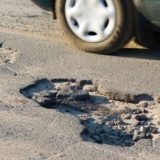
The first step in determining whether a car is totaled (or, in insurance terms, a total loss) is to calculate its actual cash value (ACV) at the time of the loss. The ACV is how much your vehicle is worth after factoring in depreciation. (On average, vehicles depreciate between 15 and 25 percent each year during the first five years.)
At Erie Insurance, a claims adjuster assesses your vehicle’s condition, then runs the make, model and year of your vehicle through an industry-leading vendor database that generates an accurate estimate of your vehicle’s current worth. The database also considers the demand for a particular vehicle in your local market; for example, a pickup truck will usually fetch a higher price in a rural area than in a heavily populated city.
Another factor is the resale value of the parts and the metal. This factor, known as the “salvage value,” is considered along with the cost of repair. At this point, there’s just one more factor to consider.
“When there’s a significant accident, there’s potentially unseen damage,” says Jeff Shultz, Vice President Material Damage, at Erie Insurance. “So we’ll factor this possibility into the repair cost to account for that.”
If a vehicle’s cost of repair plus its salvage value exceeds the vehicle’s ACV, it is typically declared a total loss. (One exception is certain state laws that require insurance companies to declare a vehicle a total loss even if the cost of repair and salvage value are less than the ACV.) Fortunately, only about 12 percent of ERIE’s auto claims are deemed total losses.
What happens next?
If your vehicle is a total loss, you have two choices: You can take the cash settlement for the ACV of your vehicle or, if your state allows, you can request the title and damaged vehicle be returned to you. (Just know that ERIE deducts the salvage value of the vehicle before selling it back to you. ERIE also reports the damaged vehicle’s VIN number to a federal database so that any future buyers know it sustained major damage.)
Most customers choose to take the settlement value, which is the figure generated by the industry-leading vehicle valuation database. Payment goes to the customer if the vehicle is owned outright. If there’s a lienholder, such as a bank or a credit union, payment goes to that lienholder. (Anything left over after paying the lienholder, however, goes back to the customer.) All payments are made after subtracting the customer’s deductible.
Good coverage for a bad situation
If you have optional collision coverage and comprehensive coverage on your ERIE auto policy, you have protection if your vehicle is declared a total loss. Collision protects you if you hit another car or overturn, while comprehensive protects against events like severe weather, hitting a deer or a fire. There are, however, two added coverages you might want to consider.
The first is Rental Car Coverage. This endorsement covers the cost of a loaner vehicle from a car rental agency if your regular vehicle is in the shop.
If you lease your vehicle (or took out a loan with little or no money down), it’s worth considering the New Auto Security Coverage Endorsement. If you have a lease or loan on your vehicle, the endorsement will bridge the gap if you owe more on the vehicle than what it’s worth. If you have a total loss vehicle that’s less than two years old, you’ll receive a new car of the same make and model.
– See more at: https://www.erieinsurance.com/Blog/2015/totaled-car#sthash.5tPiJGGI.dpuf




















